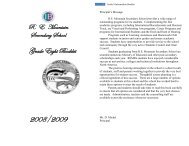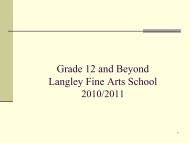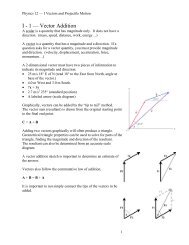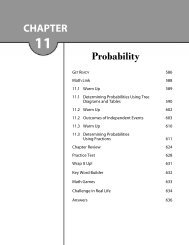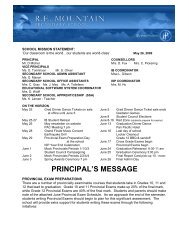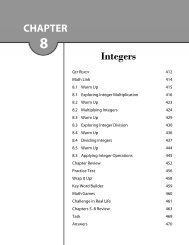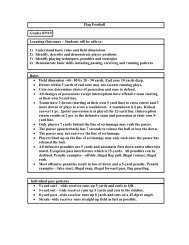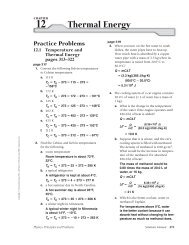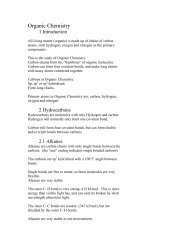Physics Solutions Manual
Physics Solutions Manual
Physics Solutions Manual
Create successful ePaper yourself
Turn your PDF publications into a flip-book with our unique Google optimized e-Paper software.
Chapter 24 continued<br />
Grasp the coil with the right hand, keeping<br />
the fingers encircling the coil in the<br />
direction of the conventional current<br />
flow through the loops. The thumb of<br />
the right hand will point toward the<br />
north pole of the electromagnet.<br />
42. Each electron in a piece of iron is like a tiny<br />
magnet. The iron, however, may not be a<br />
magnet. Explain. (24.1)<br />
The electrons are not all oriented and<br />
moving in the same direction; their<br />
magnetic fields have random directions.<br />
43. Why will dropping or heating a magnet<br />
weaken it? (24.1)<br />
The domains are jostled out of alignment.<br />
44. Describe how to use the third right-hand<br />
rule to determine the direction of force on a<br />
current-carrying wire placed in a magnetic<br />
field. (24.2)<br />
Point the fingers of your right hand in<br />
the direction of the magnetic field. Point<br />
your thumb in the direction of the conventional<br />
current in the wire. The palm<br />
of your hand then faces in the direction<br />
of the force on the wire.<br />
45. A strong current suddenly is switched on in a<br />
wire. No force acts on the wire, however. Can<br />
you conclude that there is no magnetic field<br />
at the location of the wire? Explain. (24.2)<br />
No, if a field is parallel to the wire, no<br />
force would result.<br />
46. What kind of meter is created when a shunt<br />
is added to a galvanometer? (24.2)<br />
an ammeter<br />
Applying Concepts<br />
pages 664–665<br />
47. A small bar magnet is hidden in a fixed<br />
position inside a tennis ball. Describe an<br />
experiment that you could do to find the<br />
location of the north pole and the south<br />
pole of the magnet.<br />
Use a compass. The north pole of the<br />
compass needle is attracted to the south<br />
pole of the magnet and vice versa.<br />
48. A piece of metal is attracted to one pole of a<br />
large magnet. Describe how you could tell<br />
whether the metal is a temporary magnet or<br />
a permanent magnet.<br />
Move it to the other pole. If the same<br />
end is attracted, it is a temporary<br />
magnet; if the same end is repelled and<br />
the other end is attracted, it is a permanent<br />
magnet.<br />
49. Is the magnetic force that Earth exerts on a<br />
compass needle less than, equal to, or<br />
greater than the force that the compass<br />
needle exerts on Earth? Explain.<br />
The forces are equal according to<br />
Newton’s third law.<br />
50. Compass Suppose you are lost in the<br />
woods but have a compass with you.<br />
Unfortunately, the red paint marking the<br />
north pole of the compass needle has worn<br />
off. You have a flashlight with a battery and<br />
a length of wire. How could you identify<br />
the north pole of the compass?<br />
Connect the wire to the battery so that the<br />
current is away from you in one section.<br />
Hold the compass directly above and<br />
close to that section of the wire. By the<br />
right-hand rule, the end of the compass<br />
needle that points right is the north pole.<br />
51. A magnet can attract a piece of iron that is<br />
not a permanent magnet. A charged rubber<br />
rod can attract an uncharged insulator.<br />
Describe the different microscopic processes<br />
producing these similar phenomena.<br />
The magnet causes the domains in the<br />
iron to point in the same direction. The<br />
charged rod separates the positive and<br />
negative charges in the insulator.<br />
52. A current-carrying wire runs across a laboratory<br />
bench. Describe at least two ways in<br />
which you could find the direction of the<br />
current.<br />
490 <strong>Solutions</strong> <strong>Manual</strong> <strong>Physics</strong>: Principles and Problems<br />
Copyright © Glencoe/McGraw-Hill, a division of The McGraw-Hill Companies, Inc.





